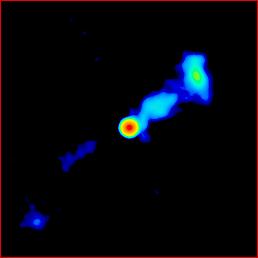 Image:
Image:3C 293 | B1350+316 |
| S178 | Alpha | FR | Class | ID | Spectrum | Best z | mag. | LAS | lg P178 | D |
|---|---|---|---|---|---|---|---|---|---|---|
| 13.8 | 0.45 | II | CD/SSC | Gal | 0.04503 | R = 13.72 | 256.00 | 24.63 | 206.8 |

| Size: | 256.0 × 256.0 arcsec² |
|---|---|
| LUT: | Logarithmic |
| Beam: | 7.6 arcsec |
| Frequency: | 1524 MHz |
| Method: | CLEAN Õ˜ÿ>7.6
|
| Telescope: | VLA B+C |
| Credits: | Leahy, Pooley & Riley (1986) |
A radio image with higher resolution and sensitivity than ours is given by Bridle, Fomalont & Cornwall (1981), but unfortunately is no longer available in digital form.
Although the outer structure is formally a classical double, the luminosity of 3C 293 is well below the FR break, and it differs from typical CDs in several respects. Most obviously, the central component is a kpc-sized steep-spectrum core, with a curious "double double structure"; see our image of the SSC on the Other Images page. In early radio maps (e.g. Argue, Riley & Pooley 1978) the large-scale structure appeared to be one-sided, with only the large NW hotspot detected. While the ratio of flux density between the two lobes is unusually high (about 4.4), the apparent one-sidedness was mainly due to the difficulty of detecting any extended emission in the presence of the bright SSC. The 'bridge' emission is brighter close to the nucleus and connects directly with it, rather than distorting or fading near the nucleus as in other classical doubles. Our "bridge" emission is superimposed on a fainter bridge visible in Bridle et al.'s map, and they suggest that the brighter component actually comes from a disrupted jet.
The steep-spectrum core has attracted a lot of attention, partly because it is interacting directly with the gas disk. Henriksen, Vallée & Bridle (1981) have suggested that the Z-shaped distortion of the SSC is due to the response of twin jets to the pressure gradient in the disk. Since the pressure is a maximum in the disk plane, the pressure gradient is perpendicular to the disk. The projected disk major axis is at PA 65° so the inner axis of the SSC (PA 90°), presumably that of the jets, is misaligned with the pressure gradient. As a result, buoyancy forces bend the jets towards the disk axis, or "refract" them, as Henriksen et al. put it. The irregular structure of the SSC, with a pair of compact edge-brightened inner lobes, then larger and fainter intermediate lobes, means that the smooth bending envisaged by Henriksen et al. was too simple, but the idea that buoyancy forces are responsible for the symmetry is very plausible.
There is a compact flat-spectrum core at the inner edge of the western lobe of the SSC (van Breugel et al 1984, Akujor et al. 1996).
The depolarization asymmetry
in the SSC (Akujor et al.) suggests that the
eastern component is on the near side, but it is possible that the asymmetry
arises because the western lobe is much closer to the nucleus, rather than
through orientation effects. In their 5 GHz MERLIN map of the SSC,
Akujor et al. detect a jet running from the
core to the "hotspot" in the eastern lobe, which again suggests that
that is the near side; although there is also a possible counter-jet.
| Prev. | Data Page | Other images | Next | Search | Alphanumeric List | Icon List | Atlas Index |
|---|